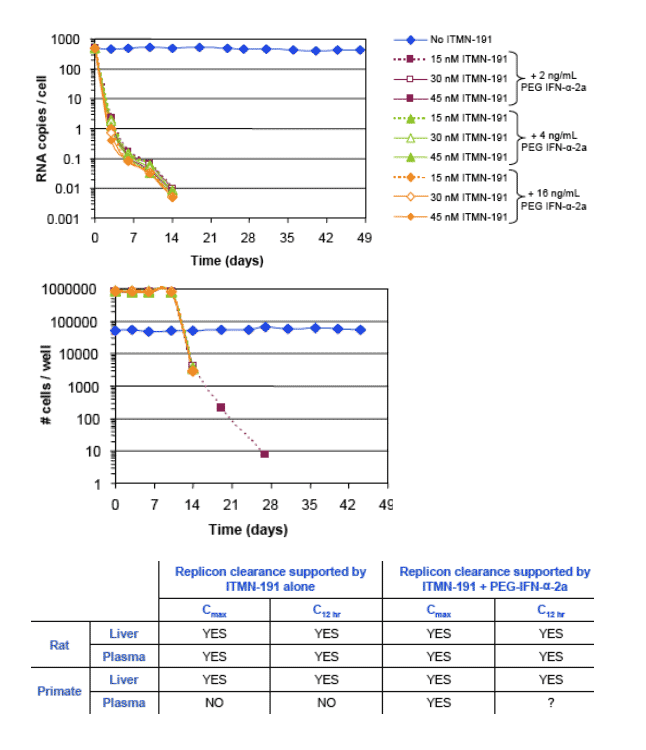 |
 |
 |
| |
ITMN-191 CONCENTRATIONS ACHIEVED IN THE LIVER OF ANIMALS PROMOTE HCV REPLICON CLEARANCE IN VITRO AND THIS EFFECT IS ENHANCED BY PEG-IFN a-2a (Pegasys)
|
| |
| |
Reported by Jules Levin
EASL, April 2007, Barcelona, Spain
L.M. Blatt, H. Tan, S.D. Seiwert
InterMune, Inc., Brisbane, CA, USA
Authors report:
"Liver concentrations of ITMN-191 in preclinical species exceed the level required to eliminate HCV replicon in vitro. With the exception of the 12 hr post dose concentration in monkey plasma, all concentrations of ITMN-191 observed in preclinical species exceed the level required to eliminate HCV replicon in vitro when combined with PEG-IFN-_-2a... When combined with the minimum human plasma concentration of PEG-IFN-_-2a, all concentrations of ITMN-191 tested (15 nM to 45 nM) reduced HCV RNA below the limit of detection (>4.7 log10 decrease) upon 14 days of treatment and resulted in complete replicon clearance from cells as judged by the inability to select for cells harboring HCV replicon in the 4 week follow up period.....
and conclude:
-- Low double digit nanomolar concentrations of ITMN-191 direct replicon clearance in vitro
-- The concentrations of ITMN-191 required for replicon clearance in vitro are exceeded in liver tissue in preclinical species
-- In many cases, plasma concentrations of ITMN-191 in preclinical species support replicon clearance in vitro
-- These data support the clinical investigation of the anti-HCV properties of ITMN-191
-- Minimal human plasma concentrations of PEG-IFN _-2a enhance the HCV replicon clearance activity of ITMN-191, supporting the combination of these two agents in clinical studies."
ABSTRACT
Background: Successful treatment of chronic HCV infection requires sustained virologic response (SVR), which is currently achieved in approximately 50% of treated patients. Direct antiviral agents may improve the rate of SVR when used in combination with the current standard of care or in novel regimens. ITMN-191 is a potent HCV NS3/4A protease inhibitor in clinical development. Here, the ability of ITMN-191 to clear HCV replicon from Huh7 cells was investigated.
Since HCV replicates primarily if not exclusively in the liver, the concentrations of ITMN-191 required for viral clearance were compared to those achieved in the liver of animals.
Methods: Cells harboring HCV genotype 1b replicon were treated for two weeks in the absence of selection for replicon retention with ITMN-191, PEG-IFN-_-2a (Pegasys), or both agents. Over a subsequent four week period, cells were counted and aliquots harvested for RTPCR-based quantification of replicon RNA levels under G418 selection for replicon retention.
Results: As little as 3.7 nM ITMN-191 promoted a 3.7 log10 reduction in
replicon levels upon 14 days of in vitro treatment but did not clear replicon from all cells as judged by the selection of G418-resistant cells in the 4 week follow up period. In contrast, 14 day treatment with 45 nM ITMN-191 (about 3-fold its IC90) reduced replicon RNA levels below the limit of detection by RT-PCR and afforded complete clearance of replicon RNA as judged by the inability to select for replicon containing cells with G418 in the 4 week follow up period. Importantly, the trough liver concentration of ITMN-191 in animals following oral BID dosing greatly exceeded 45 nM. Additionally, when combined with the minimum human plasma concentration of PEG-IFN-_-2a, 15 nM ITMN-191 promoted durable replicon clearance by the same protocol.
Conclusions: Concentrations of ITMN-191 achieved in the liver of animals following BID dosing promote replicon clearance in vitro, providing further support for the clinical investigation of the anti-HCV properties of ITMN-191. Additionally, minimal human plasma concentrations of PEG-IFN-_-2a enhance the replicon clearance activity of ITMN-191, suggesting that the combination of these two agents should also be explored in clinical studies.
HCV BACKGROUND
The goal of therapy for chronic HCV is sustained virologic response (SVR), or the complete and durable eradication of viral particles from circulation
Current standard of care results in SVR rates of approximately 50% with
lower response rates in certain subpopulations such as individuals harboring genotype 1 virus
The addition of direct acting antiviral agents to the current standard of care
may improve therapeutic outcomes
Among targets for direct antiviral agents, the protease activity of NS3/4A has emerged as a favored target
ITMN-191 (R7227): A small molecule inhibitor of NS3/4A
Protease Activity
--Developed through a structure-informed rational design campaign
--Like other inhibitors in this class, displays preferential exposure in the liver
of animals
--In phase I clinical development
--Partnered worldwide with Roche
- Binds to NS3/4A through two step mechanism
- Biochemical potency ≦ 120 pM
- Half-life of complex with NS4/4A ≥ 5 hrs
- Biochemical inhibition is stable for many hours

3.7 nM ITMN-191 (2 X IC50) reduced HCV RNA in replicon cells by 3.7 log10 after 14 days treatment.
45 nM of ITMN191 (3 X IC90) reduced HCV RNA below the limit of detection (>4.7 log10 decrease) upon 14 days of treatment and resulted in complete replicon clearance from cells as judged by the inability to select for cells harboring HCV replicon in the 4 week follow up period.

The concentration range of PEG-IFN-_-2a that corresponds to the minimum human plasma concentration reduces but does not eliminate HCV replicon RNA upon 14 day exposure.

ITMN-191 in combination with PEG IFN-_-2a
When combined with the minimum human plasma concentration of PEG-IFN-_-2a, all concentrations of ITMN-191 tested (15 nM to 45 nM) reduced HCV RNA below the limit of detection (>4.7 log10 decrease) upon 14 days of treatment and resulted in complete replicon clearance from cells as judged by the inability to select for cells harboring HCV replicon in the 4 week follow up period.

|
| |
|
 |
 |
|
|